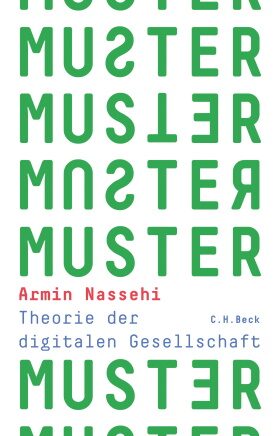Armin Nassehi
Muster. Theorie der digitalen Gesellschaft
[Patterns. Theory of the Digital Society]
- C.H.Beck Verlag
- Munich 2019
- ISBN 978-3-406-74024-4
- 352 Pages
- Publisher’s contact details
Sample translations
No Need to Panic: We Were Always Already Digital
What would Foucault have said about the epistemic upheavals of the digital age to which we often feel helplessly exposed these days? Certainly, representation initially served to make the invisible visible, for instance in the case of anatomy in medicine or that of grammar in linguistics. Yet in Nassehi's analysis, the signs – which have meanwhile been reduced to the form of zeros and ones – lead a rather productive life of their own. Decoupled from that real world which they had just stepped up to represent, they have become creative themselves. Whole worlds are emerging that no longer claim to refer to a world of reference. "The data are themselves the material with which knowledge is produced; beyond that, what is produced are goods, services, political monitoring, law enforcement, espionage, technical control, etc."
Like good old-fashioned statistics, digitalization was initially deployed to collect and combine data. The information thus garnered in turn created new realities, such as the unromantic and maximally individualized market of online dating platforms. There data are compared in order to calculate the probabilities of an individual's future happiness. Collecting, informing, and synthesizing gave rise to reality effects in the analog sphere that presently driving many cultural scientists up the wall. In the end, aren't we as autonomous and willful as the emancipatory narrative of the subject wants us to think?
What is the main thrust of Nassehi's reflections? Despite having given us so many horror visions about our lack of autonomy, digitization is not something that just came over us out of the blue. It's not some technology that has been grafted onto the individual and that is now inexorably forcing him onto his knees. It's actually the other way around: the idea that the search for patterns is a genuine part of the experience of modernity is developed by Nassehi in a provocatively anti-alarmist manner. "It wasn't the computer that created data processing but instead the centralization of rule in nation-states, the operation of cities and urban planning, as well as the need for rapidly supplying goods for an abstract number of enterprises, consumers, and metropolitan areas." Digitization is therefore the answer to a question that modern society itself has continuously raised, i.e., the question of form, structure, and its ability to be controlled.
The situation was rather different in premodern culture: “In earlier societies, for example, the social position and status of another person were always already transparent. There were even (more or less) sophisticated signs, especially those of rank and function such as those encoded by clothing. These allowed the social structure to be seen in a relatively simple fashion – an analog one. Analog here signifies what is observable by everyday means in its full empirical specificity. Relevant knowledge about society has been obtained from the mere knowledge of what one could see, combined with the forms of appraising the cultural signs that go with it. ”
Nassehi already traces the digital recognition of patterns back to our general way of communicating: complex societies that negotiate complex messages rely on pattern recognition. "For our consciousness has to know something about what it can see; otherwise, it cannot identify things." Or to paraphrase Husserl, "[w]e ultimately use our perception to test hypotheses about the world."
What is original about Nassehi's book is his access to that current issue which is making all the media theorists so anxious. While most analyses of the digital warn of its epistemological effects, this Munich-based sociologist is attempting to historicize and thereby de-dramatize them. According to his narrative, the collection of statistical data on individuals (itself the working basis of sociology) is the younger sibling of rampant computerization.
For which problem, we might ask with Nassehi himself, is digitization the solution? It addresses the problem of complex societies par excellence: of how to gain control over individual interests, individual statements, and individual phenomena that have gotten out of control in the areas of crime, consumption, and ideology. What digitization offers here is modern data management for confusing times. For it's the only way to understand the hidden drives of complex societies and predict their developments. Or to manipulate them.
Like any process, that of digitization cannot be fully understood. Nonetheless, Nassehi's study provides a stimulating view of our data-mad century while nicely complementing the widespread skepticism toward digitization – a skepticism that sometimes impedes critical thought more than inspiring it.

By Katharina Teutsch
Katharina Teutsch is a journalist and critic. She writes for newspapers and magazines such as: the Frankfurter Allgemeine Zeitung, Tagesspiegel, die Zeit, PhilosophieMagazin and for Deutschlandradio Kultur.
Publisher's Summary
We tend to assume that the triumph of digital technology has revolutionized the world within a few years. Our interpersonal relationships, our work and even the outcome of democratic elections: Everything follows completely different rules since the Internet, the social media and the various gadgets of the big tech companies exist. In his new social theory, sociologist Armin Nassehi turns the tables and shows, beyond panic and trivialization, that digitization is only a particularly sophisticated technical answer to a question that has always arisen in modern societies
Even in the nineteenth century statistical pattern detection technologies were used to recognize and control human behaviour. While we often experience digitalization as a disturbance and challenge to established routines, Nassehi sees the foundation of digital technology in modern society itself. He develops the thesis that societal regularities, structures and patterns make up the material potential for economic, political and scientific control that digitalization only refines. As a result of digitisation, society is being rediscovered today.
(Text: C.H.Beck Verlag)
